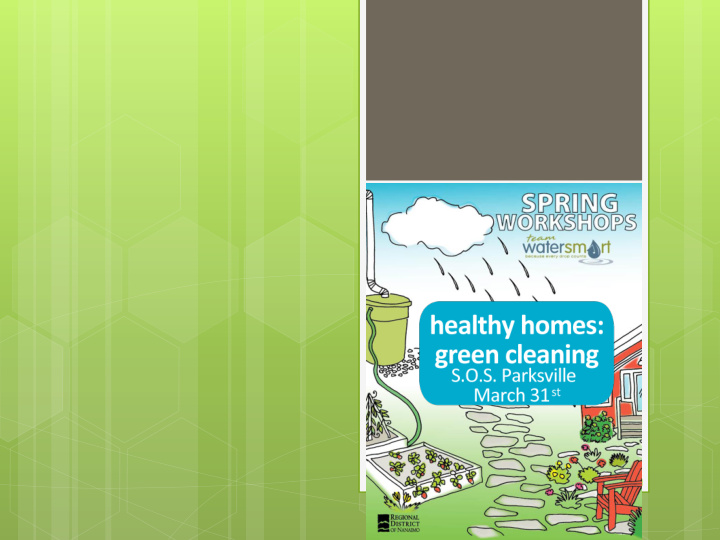



Where does water come from?
Where does it go?
Water, Sanitation and Hygiene (WASH) Photo credit: CAWST (Centre for Affordable Water and Sanitation Technology, based in Calgary)
What Does Clean Really Mean? De-odorized Dis-infected Shiny ….Toxic?
Common misconceptions: We need these products to achieve cleanliness Bacteria are scary We need a different product for each area of our home ….. $$$$
Sometimes NONE are listed Some ingredients are listed READING THE LABEL by a generic name …. fragrance – what is it?
What to Avoid Ammonia – irritating to eyes, nose, lungs Surfactants – Some biodegrade into toxic substance for fish (hormone disruptors) Tricolsan – under review by Health Canada, many concerns Fragrance Petroleum Distillates – highly volatile Phthalates – links to cancer (found in air fresheners) Phosphates – Can cause excessive algae growth, depleting aquatic ecosystems of Oxygen Chlorine compounds – acutely toxic to fish, persistent in environment, toxic gas & byproducts Parabens – Irritating to skin, hormone disruptors Butyl – Benzyl – Ethyl – Methyl – Phenol – Propyl Generally anything you cannot pronounce or that has unexplained acronyms e.g. DEA, PDCB
Biodegradable – what does it really mean? There are no standards for the biodegradable claim…. The term is applied to a wide range of products…. Even those that break down into other harmful environmental toxins can be labelled “Biodegradable”
Certification
What to Look For Non Toxic Water or Vegetable Based Easy to understand, complete list of ingredients No “ Chlor ” Phosphate Free Pump spray instead of aerosol
Other Important Issues Ingredients in Cosmetics Solvents and Paints Safe disposal Pharmaceuticals down the drain
Safe Cleaning Kit Baking Soda Vinegar Castile Soap Essential Oils Borax Washing Soda (optional) Spray Bottles Microfiber Cloth Gloves Glass Cleaning Cloth Scrub Brushes Bucket Hydrogen Peroxide
Essential Oils Smell amazing (avoid if scent-sensitive) Some have antifungal, antibacterial, and/or degreasing properties! Buyer be aware! Not all essential oils are created equal.
Sources Grocery stores – commonly stock vinegar, baking soda, and Borax Naked Naturals (Qualicum, Parksville), and Island Natural (Nanaimo) carry Essential Oils and green cleaners Soap Exchange (Nanaimo - Country Club Mall) carries Castile Soap and a wide variety of green cleaners Planet Clean (625 Townsite Rd, Nanaimo) carries a wide variety of non-toxic cleaners and supplies for residential and commercial use
How to get started... Learn the properties of the various commonplace green cleaning agents Start small… with one cleaner you use everyday Using green cleaners: Green cleaner recipes Know your ingredients and mix and match! Safety first! Always label and properly store your green cleaners
RECIPES we’ll try today…. Disinfectant Spray 2 cups water ¼ cup vinegar 2 tsp tea tree or eucalyptus oil Creamy Soft Scrub 1 2/3 cup baking soda ½ cup liquid soap dilute with ½ cup water Essential oil (optional)
Greener Cleaners Better for your health Better for the environment – both the air and the water Effective Inexpensive Fun to make & experiment with!
Resources: THANK YOU Georgia Strait Alliance Toxic Smart Materials FOR COMING! David Suzuki Foundation “Queen Of Green” Cleaning Recipes Thanks to GOOGLE for the pictures…
Recommend
More recommend